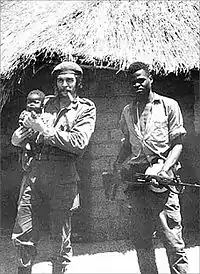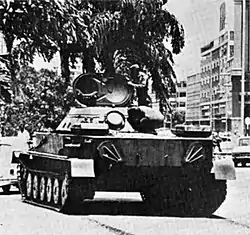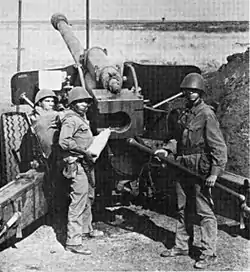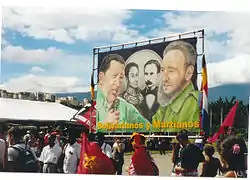Foreign interventions by Cuba
Cuba has intervened in foreign countries on various occasions. The interventionist policies of Cuba and the various proxy wars on its behalf during the Cold War were controversial and resulted in isolation.[1] Cuban leader Fidel Castro held power to militarily intervene in other countries that he perceived to be ruled by a tyrant or despot.[1] With Soviet backing, Cuba extended support to indigenous groups fighting for independence in Algeria, and in the then Portuguese colonies of Angola and Mozambique as well as to newly independent African countries like Benin, Republic of the Congo (then Congo Brazzaville), Egypt, Ghana, Guinea, Guinea-Bissau, and Mali. Following the dissolution of the Soviet Union in 1991 and facing the economic difficulties during the Special Period, Cuba's methods of military intervention were severely affected.[2] Cuba has instead adopted other methods of intervening in foreign territories.

Background
During the Cold War, Cuba often positioned itself internationally by providing direct military assistance to those who shared the same ideology and to resistance movements[3] with at least 200,000 members of the Cuban Revolutionary Armed Forces (FAR) serving in foreign territories during the period.[4] Cuba perceived its interventions to be a method of directly combating the international influence of the United States.[5] Cuba also sought to place its troops into international conflicts in order to build combat expertise among their ranks.[6]
Informally, Cuba's ambitions of foreign military intervention began shortly after the Cuban Revolution in 1959, though it was officially adopted pronounced in 1966 by Fidel Castro at the Organization of Solidarity with the People of Asia, Africa and Latin America.[1] Cuba often received military and logistical assistance from the Soviet Union and Warsaw Pact nations when participating in interventionist initiatives throughout Africa and Latin America.[7]
History
1959 Panama invasion attempt
One of the first foreign actions taken by Cuba only months after the revolution included an attempted coup in Panama on 24 April 1959.[1] The coup was repelled by members of the Panamanian National Guard.[8]
1959 Dominican Republic invasion attempt
The Dominican Republic was invaded on 14 June 1959.[9][10] Fifty-six men (Cubans, Guatemalans, Dominican exiles, and American communists)[11] landed a C-56 transport aircraft in Constanza. As soon as the invaders landed, they were massacred by the fifteen-man Dominican garrison.[12] A week later, two yachts offloaded 186 invaders onto Chris-Craft launches for a landing on the north coast. Dominican Air Force pilots fired rockets from their British-made Vampire jets into the approaching launches, killing most of the invaders.
Sand War
The first official foreign deployment of Cuba's armed forces was in Algeria during the 1963 Sand War.[13] Hundreds of Cuban troops arrived in Algeria on 22 October 1963 upon request from Algerian president Ahmed Ben Bella.[13] Castro was convinced that the United States sought Ben Balla's overthrow and was determined to prevent this from happening.[13] Under the command of Efigenio Ameijeiras, Cuba deployed twenty-two T-34 tanks, eighteen 120-mm mortars, a battery of 57-mm recoilless rifles, anti-aircraft artillery with eighteen guns, and eighteen 122mm field guns with the crews to operate them.[13] Castro sought to keep the operation covert in order to avoid international backlash, with many Cuban troops participating in the conflict wearing Algerian uniforms.[13] However, French forces quickly discovered Cuban intervention and reported it to other governments.[13]
Venezuela and Machurucuto incident
Soon after taking following the Cuban Revolution, Fidel Castro sought to take advantage of relations with Venezuela and incorporate its oil wealth within Cuba and quickly began to make relations with Venezuela guerrillas.[14] President of Venezuela Rómulo Betancourt cut ties with Cuba in 1961 as part of the Betancourt Doctrine, which saw Venezuela breaking relations with governments that came to power through non-democratic means.[15] In July 1964, the Organization of American States sanctioned Cuba after a cache of weapons destined for the Fuerzas Armadas de Liberación Nacional was discovered on Venezuela's shores.[16] In May 1967, the Machurucuto Incident saw Cuban troops attempting to make their way into the Andes to train Venezuelan guerrillas, but they were captured by the Venezuelan Army and National Guard.[17]
Congo Crisis
During the Congo Crisis, Cuba intervened between 1964 and 1965 and provided hundreds of personnel to assist the Simbas with overthrowing the Congolese government.[13] Cuba would also make contacts and provide military support to revolutionary movements during the Portuguese Colonial War beginning in the 1960s and into the 1970s.[18]
Guinea-Bissau War of Independence
Following the Congo Crisis, Cuba was supporting the African Party for the Independence of Guinea and Cape Verde during the Guinea-Bissau War of Independence.[19] Several Cubans were killed in the field by Portuguese troops.[9]
Yemenite War of 1972
Cuban pilots flew combat as well as training missions for the People's Democratic Republic of Yemen during the Yemenite War of 1972.[9]
Insurgency in the Dominican Republic
Dominican soldier and politician Francisco Caamaño was sent as a military attaché to London in January 1966. He was contacted by Cuban officials and fled to Cuba to start a guerrilla group in October 1967. He had a support group led by Amaury German Aristy that was expected to create the conditions for a victorious landing of Caamaño's commands in the Dominican Republic. This group was ambushed by the Dominican Army and killed during a fight that included heavy artillery and airplanes. During late 1973, after several years staying low-profile, Caamaño led the landing of a small group of rebels at Playa Caracoles, near Azua and then into the mountains of the Cordillera Central, with the purpose of starting a peasant revolution to overthrow Dominican President Joaquín Balaguer. After a few weeks of guerrilla war against Balaguer's regular army and not having received the much hoped-for peasant support, he was wounded and captured by Dominican government forces, and then summarily executed.
Yom Kippur War
During the Yom Kippur War in October 1973, Cuba provided 4,000 troops into Syria to provide assistance on the attack against Israel.[20] Helicopters and tanks were also provided by the Cuban military.[21] Fighting on the Golan Heights front continued until May 1974, by which time an Israeli counterattack had largely defeated the Cuban-Syrian tank forces. The Cubans reportedly suffered casualties of approximately 180 killed and 250 wounded.[22] After the signing of the Disengagement Agreement between Israel and Syria in May 1974, Israel remained in possession of the Golan Heights, and all Cuban forces were withdrawn in January 1975.
Armed resistance in Chile
Cuba was the main supporter of the communist insurgency in Chile from 1973 to 1990. Cuba provided the Marxist rebel groups MIR and FPMR with weapons and financial support, as well as shelter, training inside Cuba, and logistical support. Cuba also created an operations room to politically unite the MIR and FPMR under Cuban command.[23]
Conflicts in Angola

As the Angolan Civil War broke out, Cuban intervention in Angola was a large-scale intervention to support the People's Movement for the Liberation of Angola (MPLA). Cuba had provided military support to MPLA since the early 1960s, while they combatted Portuguese forces and in 1963 provided military training to guerrillas in Algeria during the Sand War.[24] In late-1974, Cuba sent Major Alfonso Perez Morales and Carlos Cadelo to assess the situation in Angola after receiving requests for military aid.[25] As the South African Border War intensified and more foreign actors entered into the Angolan Civil War, Cuba grew more involved. On 3 August 1975, a second Cuban mission arrived and provided US$100,000 to the MPLA.[26] By 15 August 1975, Castro had demanded that the USSR provide more assistance to the MPLA, though the demand was declined.[27] Cuban troops began to depart for Angola on 21 August 1975; important personnel utilized commercial aircraft while standard troops were transported by cargo ships.[26] On 4 November 1975, Castro launched Operation Carlota, with Cuban special forces arriving in Angola shortly after on 9 November.[28] In the Battle of Quifangondo (10 November 1975), the MPLA, supported by Cuban troops, defeated the apartheid army. On 25 November 1975, as the South African Defence Force (SADF) tried to cross a bridge, Cubans hidden along the banks of the river attacked, destroying seven armored cars and killing upwards of 90 enemy soldiers. By the end of 1975, over 25,000 Cuban troops were deployed into Angola to assist the MPLA.[29] In February 1976, Cuban forces launched Operation Pañuelo Blanco (White Handkerchief) against an estimated 700 FLEC insurgents. This operation succeeded in annihilating the FLEC force.[30] The Cuban troops came to have in the first campaign of 1975–1976 some 400 tanks, and in the final campaign of 1988, near 1,000 tanks.[31]
In 1988, Cuba returned to Angola with a vengeance. The crisis began in 1987 with an assault by Soviet-equipped government troops (the People's Armed Forces of Liberation of Angola [FAPLA]) against the pro-Western rebel movement UNITA in the country's south. Soon, the apartheid South African Defence Force invaded to support the beleaguered US-backed faction and the Angolan offensive stalled. Acting independently from Moscow, Havana reinforced its African ally with 55,000 troops, tanks, artillery and MiG-23s, prompting Pretoria to call up 140,000 reservists.[30] In June 1988, SADF armor and artillery engaged FAPLA-Cuban mechanized forces at Techipa, killing 290 Angolans and 10 Cubans.[32] In retaliation, Cuban warplanes hammered South African troops.[30] However, both sides quickly pulled back to avoid an escalation of hostilities.[30] The Battle of Cuito Cuanavale stalemated, and a peace treaty was signed in September of 1988. By the time the last Cuban forces returned home in 1991, 337,033 military personnel and some 50,000 civilians had served in Angola. The Cubans had lost some 15,000 killed, wounded or missing.
Ogaden War

During the Ogaden War (1977–1978) in which Somalia attempted to invade an Ethiopia affected by the Ethiopian Civil War, Cuba deployed 18,000 troops along with armored cars, artillery, T-62 tanks, and MiGs to assist the Provisional Military Government of Socialist Ethiopia.[33] Cuban troops and warplanes played a major part in the expulsion of Somali regulars from the Ogaden.[34] After the Ogaden War, Ethiopian leader Mengistu repeatedly requested aid by Cuban troops in his war against Eritrean separatists, but Castro refused to intervene, instead urging Mengistu to seek a negotiated solution giving Eritrea regional autonomy.[35]
Nicaraguan Revolution
During the Nicaraguan Revolution, Cuba supplied military aid and logistics to Sandinista National Liberation Front guerrillas.[36] Cuban military and intelligence personnel subsequently became incorporated into the ranks of Nicaragua's security services.[37]
United States invasion of Grenada
In 1983, the US invaded Grenada, killing 25 Cubans and expelling the remainder of the Cuban aid force from the island.
Espionage in Venezuela
Ties between Cuba and Venezuela resumed in 1974 after guerrilla activity decreased in Venezuela. When Cuba began to enter its Special Period which saw domestic economic collapse, it once again became motivated to take control of Venezuela's oil wealth.[38] In 1987, future Venezuelan president Nicolás Maduro moved to Venezuela[39] where he was trained by Pedro Miret Prieto, a senior member of the Politburo of the Communist Party of Cuba with direct links to Fidel Castro.[40] When Maduro returned to Venezuela, he was allegedly tasked with serving as a Cuban mole to infiltrate Hugo Chávez's MBR-200.[41] Venezuelan intelligence had also later discovered that Cuban Dirección de Inteligencia agents remained in Venezuela following the second inauguration of Carlos Andrés Pérez and eventually escalated political tensions during the Caracazo riots in 1989.[38]

In Venezuela, Cuba has continued to be encouraged with intervening in Venezuela so the country can receive necessary commodities and other supplies, such as oil.[42] According to retired Venezuelan General Carlos Julio Peñaloza Zambrano, Cuban agents might have entered Venezuela during Carlos Andrés Pérez's inauguration ceremony, which was attended by Castro, and may have waited for unrest to occur in Venezuela so they could exacerbate political tensions after the Caracazo.[43] Still suffering from the effects of Cuba's Special Period, Castro built a relationship with emerging political figure Hugo Chávez.[44]
1992 Venezuelan coup d'état attempts
During Chavez's 1992 Venezuelan coup d'état attempts, Castro was allegedly involved with the conspiracy and provided logistical assistance in order to establish a Venezuelan president as an ally.[45] In 1994, Chávez and other rebels were pardoned by President Rafael Caldera[46] an alleged accomplice of the 1992 coup attempts.[45] Chávez was elected president of Venezuela in 1998 and a year later in 1999, he proclaimed that "Venezuela is traveling towards the same sea as the Cuban people", calling Cuba and Venezuela "one country united".[47]
Activities in Venezuela
Following the 2002 Venezuelan coup d'état attempt, Chávez's grew even closer to the Cuban government in order to maintain power[48] and replaced military advisors with Cuban intelligence personnel.[49] Chávez and Castro would now maintain the relationship of Venezuelan commodities traded for Cuban intelligence and logistics so both could maintain popularity.[48] By 2010, former Major General Antonio Rivero claimed that about 92,700 Cuban officials were operating in various offices of Venezuela's government[42] with a 2018 claim of about 46,000 members of the Cuban Revolutionary Armed Forces within Venezuela to assist Chávez's successor, Nicolás Maduro.[50]
See also
References
- Domínguez, Jorge (1989). To Make a World Safe for Revolution: Cuba's Foreign Policy. Cambridge: Harvard University Press. pp. 114–120, 168–169. ISBN 978-0674893252.
- Klepak, Hal (2006). Cuba's Military 1990–2005: Revolutionary Soldiers During Counter-Revolutionary Times. Basingstoke: Palgrave-Macmillan. pp. 45–48. ISBN 978-1403972026.
- Abreu, José (September 5, 2011). "El internacionalismo militar cubano en la historiografía de la isla" (in Spanish). Holguín: Radio Angulo. Retrieved September 14, 2018.
- Klepak, Hal (2006). Cuba's Military 1990–2005: Revolutionary Soldiers During Counter-Revolutionary Times. Basingstoke: Palgrave-Macmillan. pp. 45–48. ISBN 978-1403972026.
- Hatzky, Christine (2015). Cubans in Angola: South-South Cooperation and Transfer of Knowledge, 1976–1991. Madison: University of Wisconsin Press. pp. 166–168. ISBN 978-0299301040.
- Klepak, Hal (2006). Cuba's Military 1990–2005: Revolutionary Soldiers During Counter-Revolutionary Times. Basingstoke: Palgrave-Macmillan. pp. 45–48. ISBN 978-1403972026.
- "La intervención militar cubana: manifestación del poder militar soviético en países del tercer mundo (1960-1993)" (PDF) (in Spanish). Retrieved September 14, 2018.
- "Rubén Miró y la invasión de cubanos a Panamá" (in Spanish). Panama City: La Estrella de Panamá. April 22, 2010. Retrieved September 14, 2018.
- "Foreign Intervention by Cuba" (PDF).
- Clodfelter, Micheal (2017). Warfare and Armed Conflicts: A Statistical Encyclopedia of Casualty and Other Figures, 1492-2015, 4th ed. McFarland. p. 637. ISBN 978-0786474707.
- Dominik George Nargele, LtCol (2007). Our Wars Overseas and at Home: Ltcol Dominik George Nargele Usmc (Ret). p. 133.
- Scheina (2003). Latin America's Wars Volume II: The Age of the Professional Soldier, 1900-2001. p. 55.
- Gleijeses, Piero (2002). Conflicting Missions: Havana, Washington, and Africa, 1959-1976. Chapel Hill, NC: University of North Carolina Press. ISBN 978-0-807-82647-8.
- Carroll, Rory (2013). Comandante : myth and reality in Hugo Chávez's Venezuela. Penguin Press: New York. pp. 98–100. ISBN 9781594204579.
- Ewell, Judith. Venezuela: A Century of Change, p.145. Stanford University Press (1984), ISBN 0-8047-1213-1
- Ewell, Judith. Venezuela and the United States: From Monroe's Hemisphere to Petroleum's Empire, p.216. University of Georgia Press (1996), ISBN 0-8203-1783-7
- TIME, 19 May 1967, Latin America: Castro's Targets
- George, Edward, The Cuban Intervention in Angola, 1965–1991, New York: Frank Cass Publishing Co., ISBN 0-415-35015-8 (2005)
- References:
- Cuba: Havana's Military Machine, the Atlantic, August 1988. "In Guinea-Bissau, Cuban combat units saw action, fighting with Amilcar Cabral's rebel army against Portuguese colonial rule."
- The Cuban Intervention in Angola, 1965-1991: From Che Guevara to Cuito Cuanavale, 2005. Page 354.
- Bourne, Peter G. (1986). Fidel: A Biography of Fidel Castro. New York: Dodd, Mead & Company.
- Perez, Cuba: Between Reform and Revolution, pp. 377–379.
- Ra’anan, G. D. (1981). The Evolution of the Soviet Use of Surrogates in Military Relations with the Third World, with Particular Emphasis on Cuban Participation in Africa. Santa Monica.
- Hudson, Rex. "Coordinating Cuba's Support for Marxist-Leninist Violence in the Americas." Cuban American National Foundation, 1988: "The degree to which Cuba and the Soviet Union are committed to overthrowing the Pinochet government by "armed struggle" was revealed on August 6, 1986, when Chilean authorities discovered the first of ten FPMR arms caches, totaling seventy tons (the largest stash of weapons ever secretly amassed by extremists in a Latin American country).... Some of the twenty-one individuals captured in connection with the FPMR arsenals, including four Cuban-trained FPMR members, told authorities of meetings in Nicaragua, training in Cuba, and months of preparation to receive the weapons, which arrived in two batches in July 1986. (247)... A State Department official confirmed that U.S. experts had positively established that Cuba sent the weapons. (248) According to Chilean officials, more than 200 individuals participated in transferring the weapons from Soviet and Cuban merchant or fishing ships into chartered Chilean fishing boats, and then in carrying them ashore in rubber dinghies (Zodiacs). (249) Chilean authorities also reported that Cuba, Nicaragua and the Soviet Union provided $20 million through an International Guerrilla Coordinating Committee (CCGI) to finance the landing of weapons and explosives in the northern zone of Chile and the subsequent failed assassination attempt made by the FPMR against General Pinochet. In that action on September 7, 1986, fifteen FPMR terrorists attacked the General's motorcade with grenades and automatic weapons, killing five members of the presidential guard and wounding ten military escorts. (250) According to Chile's director general of Investigative Police, both the FPMR and MIR receive urban guerrilla training in Cuba at the Punto Cero, Pinar del Rio, Trinidad, and Havana camps. The official added that Cuba provides logistical support, whereas the Soviet Union gives them financial and propaganda assistance, and other aid comes from Nicaragua and Libya. (251) Chile's Attorney General Ambrosio Rodríguez reported on January 22, 1988 that Cuban and Nicaraguan agents were commanding a newly created International Guerrilla Coordinating Board (presumably the CCGI) that had politically reunited the MIR and FPMR under Cuban command. He added that MIR and FPMR cadres were being trained in Cuba and East Germany.(252)"
- George, pp. 22-23, 30
- Gleijeses, pp. 244-245 (Quotations from interview with Cadelo and from Cienfuegos to Senen Casas, Havana, 22 November 1974)
- George, p. 66
- Gleijeses quoting: Westad, Odd Arne in: Moscow and the Angolan Crisis 1974-76: A New Pattern of Intervention, Cold War International Project Bulletin, n.8-9, p. 25
- George, pp. 77-78
- Cuba's African Adventure by Clive Foss, History Today, Vol 60, Issue 3, March 2010
- Weigert, S. (2011). Angola: A Modern Military History, 1961-2002.
- "Cuban Tanks".
- George, Edward (2004). The Cuban Intervention in Angola, 1965-1991: From Che Guevara to Cuito Cuanavale. Routledge.
- Gleijeses, Piero (2013). Visions of Freedom: Havana, Washington, Pretoria and the Struggle for Southern Africa, 1976-1991. Chapel Hill: The University of North Carolina Press. p. 45. ISBN 978-1-4696-0968-3.
- Impact of Cuban-Soviet Ties in the Western Hemisphere, Spring 1979: Hearings Before the Subcommittee on Inter-American Affairs of the Committee on Foreign Affairs, House of Representatives, Ninety-sixth Congress, First Session, April 25 and 26, 1979. U.S. Government Printing Office. p. 11.
- Gleijeses, Piero (2013). Visions of Freedom: Havana, Washington, Pretoria and the Struggle for Southern Africa, 1976-1991. Chapel Hill: The University of North Carolina Press. p. 325. ISBN 978-1-4696-0968-3.
- "Understanding the Iran-Contra Affairs". www.brown.edu. Retrieved 2017-04-09.
- "Las guerras secretas de Fidel Castro: Los sandinistas" (PDF). cubamatinal.com (in Spanish). August 30, 2008. Retrieved September 14, 2018.
- Peñaloza, General Carlos (2014). El Delfín de Fidel: La historia oculta tras el golpe del 4F. p. 185. ISBN 1505750334.
On February 5, 1989, the transmission of Lusinchi's command to Pérez was effected with a lavish ceremony unprecedented in a democracy. Fidel ... was pressured by the "perestroika" that threatened the existence of the Cuban communist regime. The Soviet economic problems made it urgent to control Venezuela to enjoy its oil income ... Fidel stole the show with his Bolivarian allusions of the Latin American Union and a call to fight against Yankee imperialism ... the Cubans and their materials arrived at Caracas on a bus and the buses and trucks to the Eurobuilding hotel ... they were delivered three days before the arrival of Fidel to Cuban G2 officers who paid their rent in advance and made strange demands. ... After the "coronation", part of the Cuban contingent left the country ... sources reported from Maiquetía that fewer Cubans had left than those who had entered
- Oropeza, Valentina (15 April 2013). "Perfil de Nicolás Maduro: El 'delfín' que conducirá la revolución bolivariana". El Tiempo (in Spanish). Archived from the original on 2016-03-06.
- Peñaloza, Carlos (2014). Chávez, el delfin de Fidel : la historia secreta del golpe del 4 de febrero. Miami: Alexandria Library. p. 184. ISBN 1505750334. OCLC 904959157.
Maduro had gone through a long process of formation in Cuba under the protection of Pedro Miret, the powerful Cuban commander and man very close to Fidel.
- Peñaloza, Carlos (2014). Chávez, el delfin de Fidel : la historia secreta del golpe del 4 de febrero. Miami: Alexandria Library. p. 184. ISBN 1505750334. OCLC 904959157.
... Maduro returned to Venezuela with the permission to approach Chávez acting as a mole of the G2.
- Gertz, Bill (13 December 2017). "Inside the Ring: U.S. military could lose next war: Report". The Washington Times. Retrieved 2018-12-03.
- Peñaloza, General Carlos (2014). El Delfín de Fidel: La historia oculta tras el golpe del 4F. p. 185. ISBN 1505750334.
On February 5, 1989, the transmission of Lusinchi's command to Pérez was effected with a lavish ceremony unprecedented in a democracy. Fidel ... was pressured by the "perestroika" that threatened the existence of the Cuban communist regime. The Soviet economic problems made it urgent to control Venezuela to enjoy its oil income ... Fidel stole the show with his Bolivarian allusions of the Latin American Union and a call to fight against Yankee imperialism ... the Cubans and their materials arrived at Caracas on a bus and the buses and trucks to the Eurobuilding hotel ... they were delivered three days before the arrival of Fidel to Cuban G2 officers who paid their rent in advance and made strange demands. ... After the "coronation", part of the Cuban contingent left the country ... sources reported from Maiquetía that fewer Cubans had left than those who had entered
- Carroll, Rory (2013). Comandante : myth and reality in Hugo Chávez's Venezuela. Penguin Press: New York. pp. 98–100. ISBN 9781594204579.
- Maria Delgado, Antonio (16 February 2015). "Libro devela sangriento objetivo de la intentona golpista de Hugo Chávez". El Nuevo Herald. Retrieved 17 February 2015.
- Marcano and Tyszka 2007. pp. 107–08.
- Richard Gott (2005). Hugo Chávez and the Bolivarian Revolution. Verso. p. 13. ISBN 1-84467-533-5.
- "Venezuela's Expensive Friendships". Stratfor. Retrieved 20 January 2016.
- Carroll, Rory (2013). Comandante : myth and reality in Hugo Chávez's Venezuela. Penguin Press: New York. pp. 98–100. ISBN 9781594204579.
- "Agentes cubanos asisten a Maduro para torturar a los opositores". ABC (in Spanish). Retrieved 2018-11-29.
